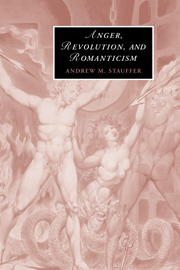Book contents
- Frontmatter
- Contents
- Acknowledgments
- List of abbreviations
- Introduction: fits of rage
- 1 Towards Romantic anger
- 2 Burke, Coleridge, and the rage for indignation
- 3 Inflammatory reactions
- 4 Provocation and the plot of anger
- 5 Shelley and the masks of anger
- 6 Byron's curse
- Epilogue
- Notes
- Bibliography
- Index
- CAMBRIDGE STUDIES IN ROMANTICISM
5 - Shelley and the masks of anger
Published online by Cambridge University Press: 22 September 2009
- Frontmatter
- Contents
- Acknowledgments
- List of abbreviations
- Introduction: fits of rage
- 1 Towards Romantic anger
- 2 Burke, Coleridge, and the rage for indignation
- 3 Inflammatory reactions
- 4 Provocation and the plot of anger
- 5 Shelley and the masks of anger
- 6 Byron's curse
- Epilogue
- Notes
- Bibliography
- Index
- CAMBRIDGE STUDIES IN ROMANTICISM
Summary
When, in A Vision, Yeats wishes to describe a particular movement upon his byzantine Wheel of Faculties, he looks to Blake and Shelley as his representative men. Blake, “The Positive Man” of Phase 16, “hates that which opposes desire,” and his hatred “is always close to madness … There is always an element of frenzy, and almost always a delight in a certain glowing or shining image of concentrated force: in the smith's forge; in the heart; in the human form in its most vigorous development.” Observing Blake's wrath, Yeats recognizes it as the fiery furnace that provides Blake with the energy that is his eternal delight. However, as the Wheel turns to Shelley (“The Daimonic Man”), this creative anger falls away. In Yeats's opinion, Shelley works best when he draws his poetry from the wellsprings of desire, but produces only “monstrous, meaningless images” when he resorts to outrage (A Vision 143). Shelley “can never see anything that opposes him as it really is,” because “He lacked the Vision of Evil, could not conceive of the world as a continual conflict, so, though great poet he certainly was, he was not of the greatest kind” (143–44).
Once raised, the charge lingers: does Shelley suffer from a kind of congenital blindness in his dealings with evil and conflict? Does he lack a vision of anger? In Shelley and the Revolutionary Idea, Gerald McNeice praises Shelley's rebellious courage, which he carefully separates from “Hatred and revenge,” passions with which “true freedom can never coexist.”
- Type
- Chapter
- Information
- Anger, Revolution, and Romanticism , pp. 110 - 132Publisher: Cambridge University PressPrint publication year: 2005



